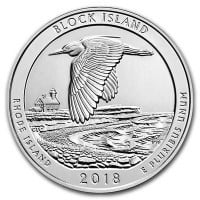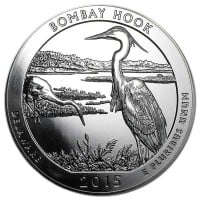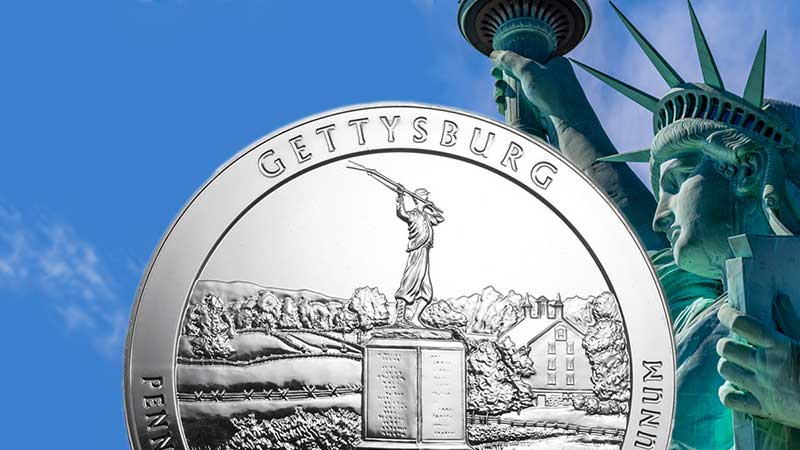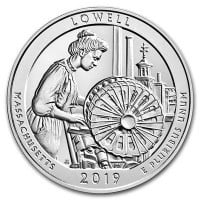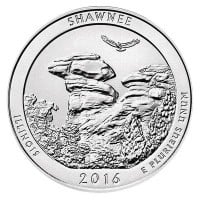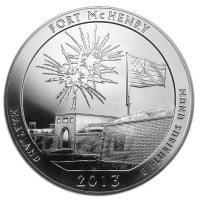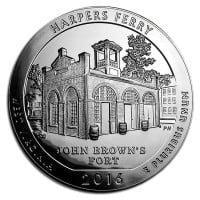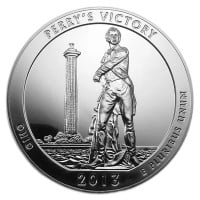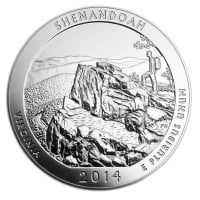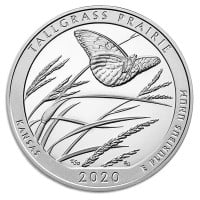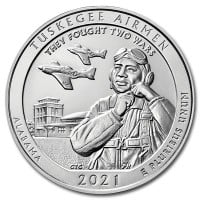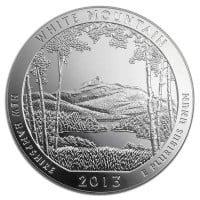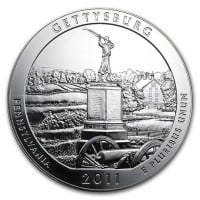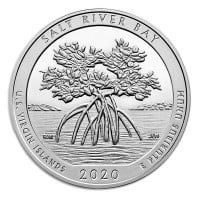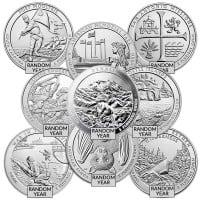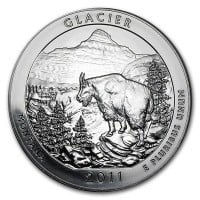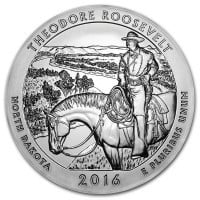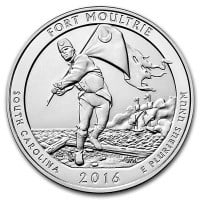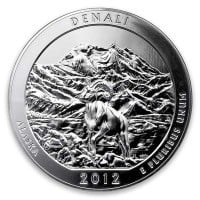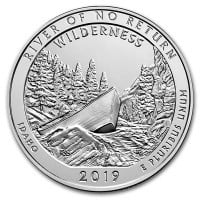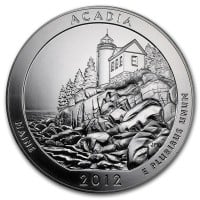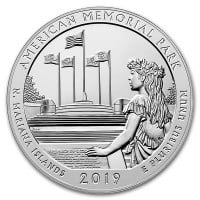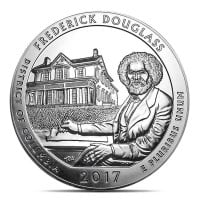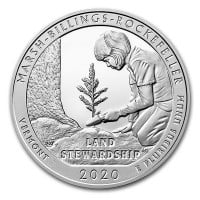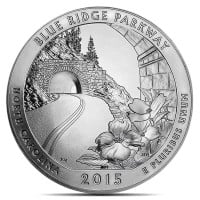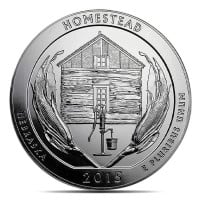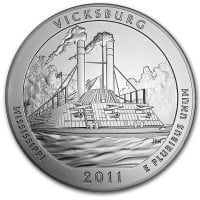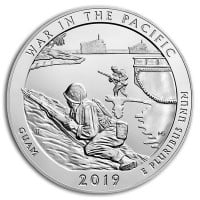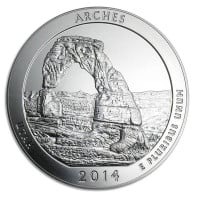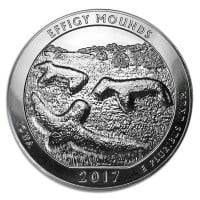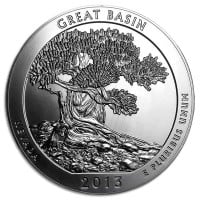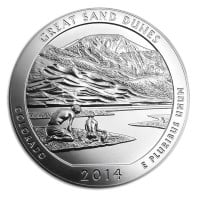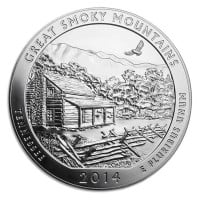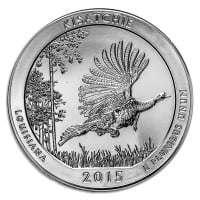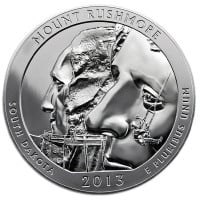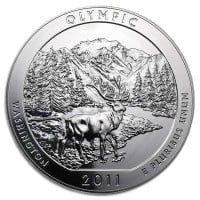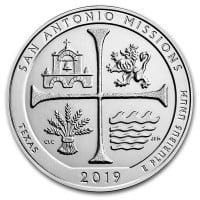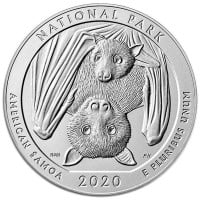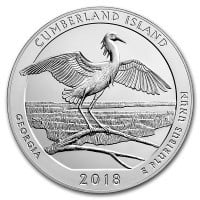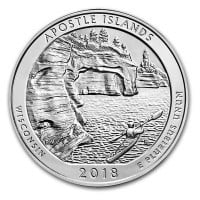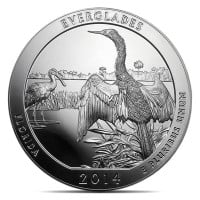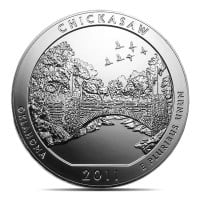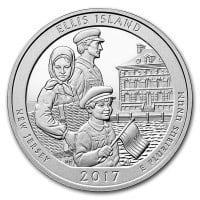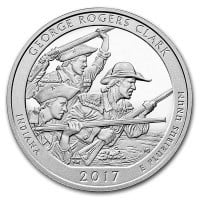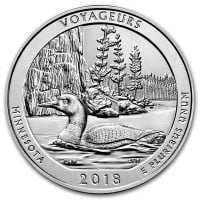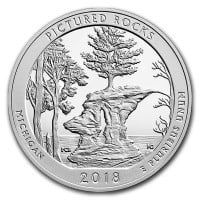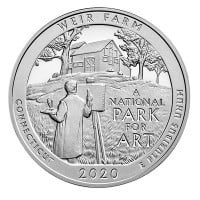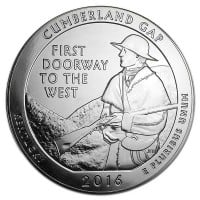Buy 5 Oz America The Beautiful Silver Bullion Coins
President Theodore Roosevelt led the effort to establish a National Park system in the early 1900s. By the time he left office, 18 had been created. Today, there are 63 National Parks and 131 National Monuments. There are also several other federally protected and managed places, including wildlife refuges, historical parks, national forests, military parks, memorials, and more.
Fifty-six of these remarkable parks and landmarks were chosen to adorn the US Mint’s America the Beautiful series of pure silver coins. These coins honor the myriad of wonderful landscapes and the rich history of our nation.
The 5-ounce America The Beautiful silver bullion coin program was authorized by Congress in Title II of the America's Beautiful National Parks Quarter Dollar Coin Act of 2008.
The name "America The Beautiful" is from the poem originally written by Katharine Lee Bates, commonly sung to the tune composed by Samuel A. Ward.
Various versions of the 5 Troy ounce America The Beautiful silver bullion quarter were minted (with a mint mark) at the Philadelphia Mint (P), the Denver Mint (D), the San Francisco Mint (S), and the West Point Mint (W or V75).
These massive 5-ounce coins will be a remarkable addition to any silver metal holdings. And, because they can be purchased without paying high collectible premiums, they make great investments.
The coins are legal tender currency with a face value of 25 cents. Although no one in their right mind would use one for a 25-cent purchase, considering the size and the silver coin value of the bullion that makes the coin. You certainly would not pay the price of twenty-five cents for the silver round value or coins. Silver prices have been rising slowly over the years, along with other precious metals of gold, platinum, palladium, and rhodium.
Teddy Roosevelt and the modern America The Beautiful silver coin program promoted federally controlled, government, national parks across the country over the more traditional advocacy for indivisible individual rights, the Constitution, justice, freedom, liberty, patriotism, democracy, the republic, courage, or pride.
The Royal Canadian Mint has a number of their 5-ounce weight silver strike coin equivalent for sale that has the face of the British Queen, Elizabeth II, on the obverse, and the famous dancing maple leafs on the reverse. However, these coins from Canada have a $50 (CAD) face value as opposed to $0.25 (USD). The Canadian coin is also .9999 fine while the American coin remains at .999 pure silver.
America the Beautiful Silver Coin Design
Each America the Beautiful (ATB) coin carries the same design on the obverse. 5 various new designs for the reverse (tails) are released each year following the start of the program. Buyers will recognize the familiar obverse (heads) side profile bust portrait of George Washington, the same coin image design featured on currently circulating quarters, only greatly enlarged to fit the 5 oz size. The coin's obverse designers were John Flanagan, Jean-Antoine Houdon, and William Cousins.
The coins are composed of .999 fine silver and have a diameter of 76.2 mm, making them the largest silver coins ever issued by the United States Mint. Because of the coin's millesimal fineness, the ATB series qualifies for a Precious Metals Silver IRA.
The coin's edge is reeded with 119 reeds. The inscriptions on the obverse (heads) include "United States of America," "Liberty," "In God We Trust," and, "Quarter Dollar."
Each coin’s reverse (tails) side varies depending upon the place being commemorated. The reverse displays the dedicated images, and has such details as the names of the locations, important figures, the states or territories, the years, and "E Pluribus Unum."
The list of sites to adorn the 56 coins was chosen in a process that included state governors, the US Interior Department, the Secretary of the Treasury, the US Commission of Fine Arts, and the Citizens Coinage Advisory Committee.
The design for each version of the coin was created by artists in the US Mint’s Artistic Infusion Program. This program was established in 2003 to include professional American artists from diverse backgrounds and who hold diverse interests. Artists collaborate with US Mint staff to craft images that work well on coinage.
The five-ounce silver quarter is typically sold to collectors in plastic cases as opposed to tubes that normal-sized quarters are put into. These coins can also be purchased in box sets of various quantities and at nearly any amount for order. Some dealers may send you sets from a random year, or an item or products from a particular year.
Be sure to look for the best deals on silver to buy from reputable companies that provide adequate information, such as Money Metals Exchange.
ATB Series Launched in 2010
The first coin in the series, honoring Hot Springs National Park in Arkansas, was issued in 2010. America the Beautiful Silver Coins are a series of 5-ounce silver coins issued by the United States Mint since 2010. Four additional coins followed with the release of the same 2010 date. Each year thereafter, 5 new designs are released celebrating a variety of federally cherished locations and commemoratives for collectors and investors alike. The coins are issued in both uncirculated and proof versions.
Here is the list of 2010 Silver ATB coins:
- Arkansas - Hot Springs National Park: The park’s origins go back to 1832 when Congress established a reservation for future recreational use. It was the first time federal land had been set aside for such a purpose. The reservation later became a National Park.
- Wyoming - Yellowstone National Park: This National Park borders 3 northwestern states, including Wyoming, Idaho, and Montana. No other park attracts more visitors each year.
- California - Yosemite National Park: Another treasure in the National Park System, famous for the vistas of Yosemite Valley and El Capitan.
- Arizona – Grand Canyon National Park: The Grand Canyon is certainly one of the great natural wonders of the world, inspired by its immensity.
- Oregon - Mt. Hood National Forest: Oregon is famous for its green forests and the snow-capped Cascade Mountain range.
2011 ATB Silver Coins
- Pennsylvania – Gettysburg National Military Park: More than 600,000 Americans perished during the Civil War and the Battle of Gettysburg was the bloodiest of all battles fought during that conflict. The coin commemorates that storied battlefield, established as a national park in 1895. Philadelphia, Pennsylvania is home to the Philadelphia Mint, and inspired other US mints and mintages.
- Montana - Glacier National Park: The Rocky Mountains are the tallest in the US. The snow-capped peaks in Glacier National Park are among that range’s most scenic.
- Washington - Olympic National Park: Mount Olympia, located on Washington’s Olympic Peninsula, includes several disparate ecosystems. These range from old-growth forests to the glacier-capped peak of the park’s mountain namesake.
- Mississippi - Vicksburg National Military Park: The battle of Vicksburg, the culmination of the longer Vicksburg Campaign, was a significant turning point in the Civil War. The Confederacy suffered painful defeat deep within its territory and the Military Park at Vicksburg commemorates that history.
- Oklahoma - Chickasaw National Recreation Area: This beautiful spot stands out in the otherwise more flat and arid state of Oklahoma. Visitors can hike in the foothills of the Arbuckle Mountains, and view scenic rivers and trees.
2012 ATB Silver Coins
- Puerto Rico – El Yunque National Forest: The first coin to be minted with a 2012 date is also the first in the series to represent a US Territory – Puerto Rico. El Yunque National Forest, a tropical rain forest, is the only one of its kind in the US National Forest system.
- New Mexico - Chaco Culture National Historical Park: The Park is filled with pueblos, what remains of Native American communities that once populated the region. There is no better place to view the history of the people who once called the desert Southwest home.
- Maine - Acadia National Park: The Park covers 47,000 acres of scenic Atlantic coastal land, mostly situated upon Mount Desert Island. Landscapes range from rocky beaches to the peak of Cadillac Mountain, the highest spot to be found anywhere on the Atlantic coast.
- Hawaii - Hawaii Volcanoes National Park: Visitors will find two of the most active volcanoes on the planet, along with museums, trails, tours, and visitor centers dedicated to volcanology and the biome that has developed around them.
- Alaska - Denali National Park: Mount McKinley, the highest peak in North America, was renamed Denali and stands at the center of 6 million acres of Alaskan wilderness set aside for protection. Along with the 20,310-foot mountain, there is a host of wildlife and beautiful vistas for visitors to enjoy.
2013 ATB Silver Coins
- New Hampshire - White Mountain National Forest: The Northeast is well-known for the spectacular “Fall colors” as leaves turn during the autumn in that region’s deciduous forests. There is no better place to see those colors than the White Mountain National Forest.
- Ohio - Perry’s Victory and International Peace Memorial: Admiral Oliver Perry led the US fleet to victory in the Battle of Lake Erie during the War of 1812. This victory and the history surrounding it are memorialized in this modest-sized park along the shores of Lake Erie.
- Nevada - The Great Basin Park National Park: Established in 1986, the Park is among those created more recently. It is a showcase for landscapes found in the Great Basin, including Wheeler Peak and its population of bighorn sheep, and bristlecone pine forest.
- Maryland - Fort McHenry National Monument and Historic Shrine: The Fort helped defend Baltimore Harbor from a British attack during the War of 1812. The flag flying above the fort following that victory inspired Francis Scott Key to write his famous poem, which would later become known as The Star-Spangled Banner.
- South Dakota - Mount Rushmore National Memorial: One of America’s most iconic landmarks was completed in 1941. The massive sculpted busts of George Washington, Thomas Jefferson, Theodore Roosevelt, and Abraham Lincoln were carved into the granite of Mount Rushmore, in South Dakota’s Black Hills.
2014 ATB Silver Coins
- Tennessee - Great Smoky Mountains National Park: The Park includes beautiful deciduous forests, rivers, waterfalls, and the Appalachian Mountains. Visitors can even hike along a section of the Appalachian Trail.
- Virginia - Shenandoah National Park: Shenandoah is yet another National Park set amongst the vast and scenic Appalachian Mountain system – specifically in Virginia’s Blue Ridge Mountains. The park is known for its spectacular scenery and plentiful wildlife.
- Utah - Arches National Park: Delicate Arch is perhaps the most widely pictured and most iconic of the sandstone arches included in this desert preserve. However, there are more than 2,000 other examples of these natural bridges for visitors to enjoy.
- Colorado – Great Sand Dunes National Park: The tallest sand dunes in North America are located in the inland state of Colorado. Visitors can also find aspen forests, lakes, and tundra in this unique section of the West.
- Florida - Everglades National Park: The Florida Everglades are not just a national treasure, they are also a World Heritage Site and International Biosphere Reserve. The habitat and wildlife protected there include rare and endangered species such as the Florida panther and manatee.
2015 ATB Silver Coins
- Nebraska - Homestead National Monument of America: The Homestead Act of 1862 allowed any qualified person to claim up to 160 acres of federal land in return for a commitment to live upon, cultivate, and otherwise improve that land. The promise of land ownership helped drive America’s westward expansion.
- Louisiana - Kisatchie National Forest: There is but one National Forest in Louisiana. Visitors there can find longleaf pine forests covering the hills and hardwood trees blanketing the valleys.
- North Carolina - Blue Ridge Parkway: The 469-mile stretch of highway is the longest linear park administered by the National Park Service. It connects two other National Parks – Shenandoah and the Great Smoky Mountains.
- Delaware - Bombay Hook National Wildlife Refuge: 15,978 acres have been set aside on Delaware Bay to provide sanctuary for migratory waterfowl along the Atlantic Flyway.
- New York - Saratoga National Historical Park: Americans won their first significant battle in the Revolutionary War at Saratoga. The victory prompted France to recognize America’s independence from Britain and join the war as an ally to the colonial forces.
2016 ATB Silver Coins
- Illinois - Shawnee National Forest: The forest lies in southern Illinois, between the Mississippi and Ohio rivers. Visitors can see the Garden of the Gods and its sandstone formations and cliffs, along with lakes, rivers, and waterfalls.
- Kentucky - The Cumberland Gap National Historical Park: The Cumberland Gap is a pass in the Cumberland Mountains. It is considered the “First Great Gateway to the West.” Pioneers beginning their journey westward traveled through it, leaving a rich history in their wake.
- West Virginia - Harpers Ferry National Historical Park: Robert Harper bought land at the confluence of the Potomac and Shenandoah rivers in 1752. The ferry business he established there provided the foundation for the community that later grew up around the river crossing – a community that played a prominent role in early US history.
- North Dakota - Theodore Roosevelt National Park: The President credited with founding the National Park system is memorialized with a park named in his honor. Roosevelt was captivated by the herds of bison and rolling hills when he first visited the area in 1883 and the experience started him along the road to conservation.
- South Carolina - Fort Moultrie National Historical Park: The fort was built to defend the city of Charleston, SC, but the fortifications were not complete in time to fend off British occupation for some time during the Revolutionary War.
2017 ATB Silver Coins
- Iowa - Effigy Mounds National Monument: Prehistoric Americans built mounds in this section of Iowa more than a thousand years ago. Many are in the shape of animals, including a bear and birds.
- Washington DC - Frederick Douglass National Historic Site: Douglass is a hero in the struggle to end slavery. The Abolitionist spent his final 17 years in the Anacostia home at the center of this historical site. The U.S. capital is Washington, District of Columbia.
- Missouri - Ozark National Scenic Riverways: The first National Park designed to protect a river system that encompasses the Jack’s Fork and Current Rivers in Missouri. Visitors will find caves, trails, and plenty of history.
- New Jersey – Ellis Island National Monument: America is a nation of immigrants, many of whom found entry to our land through Ellis Island. 12 million people passed through the port of entry from 1892 to 1954.
- Indiana - George Rogers Clark National Historical Park: Colonel Clark and his men defeated the British garrison at Fort Sackville in 1779, helping cement the United States' claim on the western frontier.
2018 ATB Silver Coins
- Michigan - Pictured Rocks National Lakeshore: The southern shore of Lake Superior features some unusual sandstone formations and beautiful, multi-hued cliffs – the Pictured Rocks. But that isn’t all. Visitors can also find shipwrecks, white birch forests, and beaches.
- Wisconsin - Apostle Islands National Lake Shore: The Apostle Islands are located on Lake Superior, just north of Wisconsin’s Bayfield Peninsula. There are 21 islands in all, plus 12 miles of lakeshore on the mainland. The park is filled with beaches, history, and plenty of recreational opportunities.
- Minnesota - Voyageurs National Park: The Fur Trade played a major role in early American history, particularly in the “10,000 lakes” region of Minnesota. Voyageurs Park preserves the history of the region, including the period when French trappers worked their trade and mingled with the Native population of the area.
- Georgia - Cumberland Island National Seashore: Most of Cumberland Island, located off of Georgia’s southern Atlantic coastline, is protected. The park preserves habitat which provides home to numerous bird species and sites showcasing both the beautiful and ugly history of the region including that of the Native Americans, early missionaries, and African American slaves.
- Rhode Island - Block Island National Wildlife Refuge: Block Island lies 12 miles offshore from Rhode Island. The island has been only lightly touched by man and provides some key habitat for migratory songbirds.
ATB Silver Coins in 2019 and Beyond
The coin series will add new coins each year until 2021, when the final coin is scheduled to be released. The following coins are upcoming, as of this writing:
2019 America the Beautiful Coins
- Massachusetts – Lowell National Historical Park
- Northern Marianas Islands – American Memorial Park
- Guam – War in the Pacific National Historical Park
- Texas – San Antonio Missions National Historical Park
- Idaho – Frank-Church River of No Return Wilderness
2020 America the Beautiful Coins
- American Samoa – National Park of American Samoa
- Connecticut – Weir Farm National Historic Site
- U.S. Virgin Islands – Salt River Bay National Historical Park and Ecological Preserve
- Vermont – Marsh-Billings-Rockefeller National Historical Park (VT)
- Kansas – Tallgrass Prairie National Preserve
2021 America the Beautiful Coins
- Alabama – Tuskegee Airmen National Historic Site
